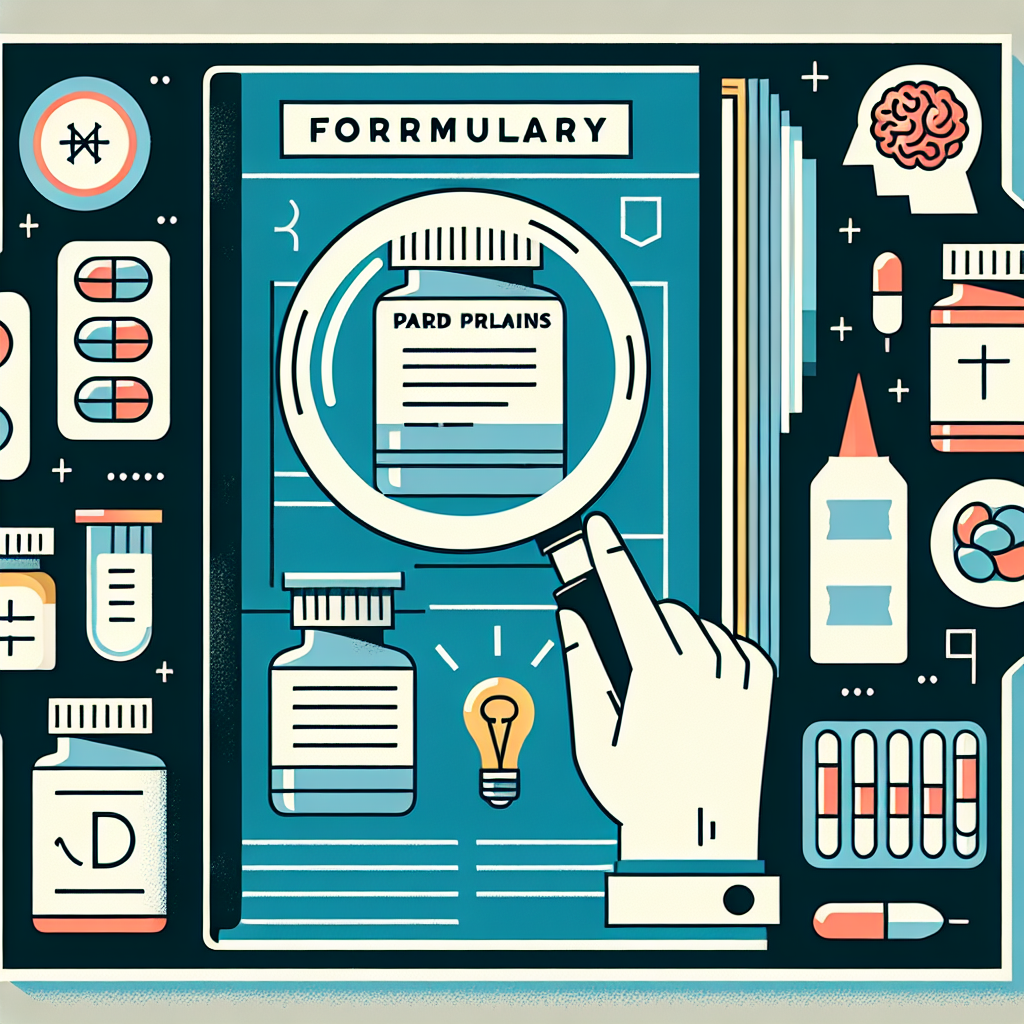Navigating the world of Medicare Part D Plans Formulary can be a daunting task for many seniors. This essential component of Medicare provides coverage for prescription drugs, but understanding the intricate details of what is covered and how much it will cost can be overwhelming. In this article, we will delve into the complexities of Medicare Part D Plans Formulary, providing you with the knowledge you need to make informed decisions about your healthcare. From tiered pricing to coverage restrictions, we will explore all aspects of the formulary to ensure you have a clear understanding of what to expect. Join us on this journey to unravel the mysteries of Medicare Part D Plans Formulary.
Understanding Medicare Part D Plans Formulary

Medicare Part D Plans Formulary plays a crucial role in determining which prescription drugs are covered under a specific Medicare Part D plan. The formulary is essentially a list of approved medications that are eligible for coverage by the plan. It is a comprehensive document that outlines the drugs that are included in the plan’s coverage and specifies any restrictions or limitations associated with each medication.
Definition of Medicare Part D Plans Formulary
The Medicare Part D Plans Formulary is a dynamic list that can be updated periodically by insurance providers to reflect changes in available medications, pricing, and coverage policies. It is essential for beneficiaries to review the formulary of their chosen plan to ensure that their prescribed medications are covered. The formulary typically categorizes drugs into different tiers based on their cost and coverage criteria, with Tier 1 containing generic drugs with the lowest copayment and Tier 4 or higher including specialty medications with higher out-of-pocket costs.
Importance of Formulary in Prescription Drug Coverage
Understanding the formulary of a Medicare Part D plan is crucial for beneficiaries to make informed decisions about their prescription drug coverage. By familiarizing themselves with the formulary, individuals can determine which medications are covered by their plan, the associated costs, and any coverage restrictions that may apply. This knowledge empowers beneficiaries to work with their healthcare providers to select cost-effective medications that are included in the formulary, thereby maximizing their coverage benefits and minimizing out-of-pocket expenses. Additionally, being aware of the formulary can help beneficiaries navigate the prior authorization process, step therapy requirements, and other utilization management tools implemented by insurance providers to manage drug costs and promote the use of generic alternatives.
Types of Drugs Covered
Understanding Medicare Part D Plans Formulary
Medicare Part D plans formulary includes various types of drugs to cater to the diverse medical needs of beneficiaries. Understanding the different categories of drugs covered can help individuals make informed decisions when selecting a plan. The types of drugs commonly included in Medicare Part D formularies are:
- Brand-name Drugs: These are medications that are sold under a specific brand name by a pharmaceutical company. Brand-name drugs are typically protected by patents, which give the manufacturer exclusive rights to produce and sell the medication for a certain period. These drugs are often more expensive than their generic counterparts but may be necessary for some individuals based on their medical condition or treatment plan.
- Generic Drugs: Generic drugs are bioequivalent to brand-name medications in terms of dosage, strength, safety, route of administration, quality, performance characteristics, and intended use. However, they are typically available at a lower cost because they do not carry the same research and development expenses as brand-name drugs. Generic drugs can provide significant cost savings for Medicare beneficiaries without compromising on quality or efficacy.
- Specialty Drugs: Specialty drugs are high-cost medications that are used to treat complex or chronic conditions such as cancer, rheumatoid arthritis, multiple sclerosis, and hepatitis C. These drugs often require special storage, handling, administration, or monitoring due to their unique characteristics. Medicare Part D plans may cover specialty drugs, but beneficiaries may be subject to additional requirements such as prior authorization, step therapy, or quantity limits to ensure appropriate use and cost containment.
Drug Tier System
Explanation of Tiers
In the realm of Medicare Part D Plans formulary, the drug tier system is a crucial component that dictates the cost of medications for beneficiaries. These tiers categorize drugs based on various factors such as their generic or brand name, effectiveness, and cost. Typically, Medicare Part D plans consist of several tiers, with each tier representing a different level of cost-sharing for the individual.
Cost Differences among Tiers
The cost disparities among the tiers can significantly impact the out-of-pocket expenses for beneficiaries. Generally, drugs placed in lower tiers are more affordable, requiring minimal copayments or coinsurance. In contrast, medications in higher tiers often come with higher out-of-pocket costs, making them less economical for beneficiaries. Understanding the cost variances among the tiers is essential for beneficiaries to make informed decisions regarding their medication choices and budgeting.

How Formularies Are Developed
Formularies within Medicare Part D plans are meticulously developed through a structured process that involves various key stakeholders to ensure comprehensive coverage for beneficiaries.
Role of Pharmacy and Therapeutics Committee
- Central to the development of formularies is the Pharmacy and Therapeutics (P&T) Committee, comprising pharmacists, physicians, and other healthcare experts. This committee plays a pivotal role in evaluating medications based on their safety, efficacy, and cost-effectiveness.
- The P&T Committee reviews clinical data, drug utilization trends, and emerging research to make informed decisions about which drugs to include on the formulary. Their goal is to strike a balance between providing access to essential medications and managing costs for both the plan and its members.
- The committee also considers feedback from healthcare providers, pharmacists, and patients to ensure that the formulary meets the diverse needs of the Medicare Part D population.
Considerations in Formulary Development
- When developing formularies, key considerations include the therapeutic value of medications, potential drug interactions, and the availability of generic alternatives. The committee prioritizes including drugs that offer significant clinical benefits while being mindful of potential risks and side effects.
- Cost is another critical factor in formulary development. The committee evaluates drug pricing, rebates from manufacturers, and overall budget impact to create a formulary that provides value for both the plan and its members.
- Formularies are regularly reviewed and updated to reflect changes in the healthcare landscape, such as the introduction of new medications, shifts in treatment guidelines, and emerging safety concerns. This ongoing evaluation ensures that Medicare Part D beneficiaries have access to the most effective and affordable medications available.
Formulary Changes
Medicare Part D plans’ formularies are subject to periodic adjustments and modifications to optimize coverage and cost-effectiveness for beneficiaries. Understanding the reasons behind formulary changes is crucial for beneficiaries to navigate their prescription drug coverage effectively.
- Reasons for Formulary Changes
- New Drug Approvals: Pharmaceutical innovations lead to the introduction of new medications that may be added to formularies, providing beneficiaries with access to cutting-edge treatments.
- Drug Safety Concerns: Formulary changes can occur in response to safety alerts or recalls issued by the FDA, ensuring that beneficiaries are not exposed to potentially harmful medications.
- Cost Considerations: Changes in drug pricing, including the availability of generic alternatives or negotiating lower prices with manufacturers, can influence formulary adjustments to enhance affordability.
- Therapeutic Advances: Clinical research and evolving medical guidelines may prompt formulary changes to promote the use of more effective or preferred medications for specific health conditions.
- Notification Process for Members
- Beneficiaries are typically informed about formulary changes through annual notices provided by their Medicare Part D plan.
- These notifications detail alterations to the formulary, such as drug additions, removals, or coverage restrictions, allowing beneficiaries to anticipate and adapt to upcoming changes in their prescription drug coverage.

- It is essential for beneficiaries to review these notifications carefully to understand how formulary changes may impact their medication access and out-of-pocket costs, empowering them to make informed decisions about their healthcare needs.
Navigating Formulary Restrictions
When it comes to understanding Medicare Part D plans’ formulary, being aware of the various restrictions imposed can significantly impact your access to medications. These restrictions are put in place by insurance providers to manage costs and ensure the appropriate use of medications. Here are the key formulary restrictions you need to navigate:
Prior Authorization
Prior authorization is a common formulary restriction that requires you to get approval from your insurance provider before they will cover certain medications. This process typically involves your healthcare provider submitting additional information to justify the need for the medication. Prior authorization is often required for expensive or potentially risky drugs to ensure they are being used appropriately.
Step Therapy
Step therapy is another form of restriction where you may be required to try one or more alternative medications before the insurance provider will cover the originally prescribed drug. This approach aims to control costs by starting with lower-cost options and escalating to more expensive drugs only if necessary. Understanding the step therapy requirements of your Medicare Part D plan can help you navigate the process more effectively.
Quantity Limits
Quantity limits restrict the amount of medication you can receive over a certain period. Insurance providers may limit the quantity to ensure the safe and appropriate use of medications, prevent overuse or stockpiling, and manage costs. It is essential to be aware of these limits, as exceeding them may result in out-of-pocket expenses or coverage denials. By understanding and adhering to quantity limits, you can effectively manage your medication supply within the constraints of your Medicare Part D plan’s formulary.
Appealing Formulary Decisions
When facing restrictions within a Medicare Part D plan’s formulary, it is crucial to understand the process of appealing formulary decisions. This can provide an avenue for beneficiaries to challenge coverage denials or restrictions on specific medications. Here is a detailed look at the steps involved in appealing formulary decisions:
- Process for Filing an Appeal
- To initiate the appeals process, beneficiaries must first review the Explanation of Benefits (EOB) or the denial notice provided by their Part D plan. This document outlines the reasons for the coverage denial or restriction.
- Next, beneficiaries should gather supporting documentation from their healthcare provider, such as medical records or a letter of medical necessity, to strengthen their appeal.
- The appeal can typically be filed online, by phone, or in writing directly to the Part D plan within a specified timeframe indicated in the denial notice.
- It is essential to ensure that all necessary information and documentation are included to support the appeal and increase the chances of a favorable decision.
- Receiving a Decision
- Once the appeal is submitted, the Part D plan will review the case and make a decision within a designated timeframe, which is usually expedited for urgent medical situations.
- Beneficiaries will receive written notification of the appeal decision, including the rationale behind the determination.
- If the appeal is approved, the medication in question may be covered as requested. However, if the appeal is denied, beneficiaries have the right to request a further review, known as a reconsideration.
- Throughout the appeals process, communication with the Part D plan and healthcare providers is key to providing any additional information required and ensuring a thorough review of the case.
Tips for Maximizing Formulary Benefits
When navigating the complexities of Medicare Part D Plans Formulary, understanding how to maximize the benefits can significantly impact your healthcare costs and coverage. Here are some essential tips to help you make the most of your formulary benefits:
- Choosing a Plan with Preferred Pharmacies
Selecting a Medicare Part D plan that includes preferred pharmacies can lead to substantial cost savings. Preferred pharmacies often offer lower copayments or coinsurance for medications listed in the formulary. By filling prescriptions at these pharmacies, beneficiaries can take advantage of discounted rates, ultimately reducing out-of-pocket expenses.
- Utilizing Mail-Order Options
Many Medicare Part D plans provide the convenience of mail-order options for prescription refills. Utilizing mail-order services can not only save time but also offer cost savings on medications. Mail-order pharmacies frequently offer discounts on prescription drugs, making them a cost-effective choice for beneficiaries who require long-term medication maintenance.
- Discussing Formulary Coverage with Healthcare Providers
Engaging in conversations with healthcare providers about formulary coverage is crucial for optimizing benefits. Physicians and pharmacists can help navigate the formulary to identify covered medications that align with the beneficiary’s healthcare needs. By discussing formulary coverage with healthcare providers, beneficiaries can explore alternative medications or therapeutic options that are both effective and cost-efficient within the plan’s formulary.
Staying Informed
Staying informed about the intricacies of Medicare Part D plans’ formulary is crucial for maximizing benefits and ensuring adequate coverage for prescription medications. Here are some key points to consider:
- Regularly Checking Formulary Updates: Medicare Part D plans can modify their formularies throughout the year, affecting coverage and costs of medications. It is essential for beneficiaries to stay updated on these changes to avoid unexpected out-of-pocket expenses. By regularly checking formulary updates, individuals can proactively identify any alterations that may impact their prescription drug coverage.
- Understanding Annual Coverage Changes: Each year, Medicare Part D plans may adjust their formularies, which can lead to variations in coverage for specific medications. Beneficiaries should familiarize themselves with the annual coverage changes to anticipate any shifts in cost-sharing requirements or drug restrictions. By understanding these modifications, individuals can make informed decisions about their medication management and seek alternatives if necessary.
FAQs: Exploring the Intricacies of Medicare Part D Plans Formulary: What You Need to Know
What is a Medicare Part D Plans Formulary?
A Medicare Part D Plans Formulary is a list of prescription drugs that a particular Medicare drug plan covers. It includes both generic and brand-name prescription medications that have been approved by the Food and Drug Administration (FDA).
How often do Medicare Part D Plans Formularies change?
Medicare Part D Plans Formularies can change at any time throughout the year. However, Medicare requires that plans update their formularies at least once a year. It is important for beneficiaries to review their plan’s formulary annually to ensure that their medications are still covered.
Why is it important to check the formulary before enrolling in a Medicare Part D Plan?
It is crucial to check the formulary of a Medicare Part D Plan before enrolling to ensure that the plan covers the specific medications that you need. If your medications are not on the formulary, you may incur higher out-of-pocket costs or be required to switch to a different medication.
Can Medicare Part D Plans Formularies vary between different insurance providers?
Yes, Medicare Part D Plans Formularies can vary between different insurance providers. Each plan has its own formulary, which is why it is important to compare multiple plans to find one that best meets your prescription drug needs.
How can I find out if a specific medication is included in a Medicare Part D Plan’s formulary?
You can check a Medicare Part D Plan’s formulary by visiting the plan’s website, calling the plan’s customer service hotline, or using Medicare’s online Plan Finder tool. These resources will allow you to search for a specific medication and determine if it is covered by a particular plan.